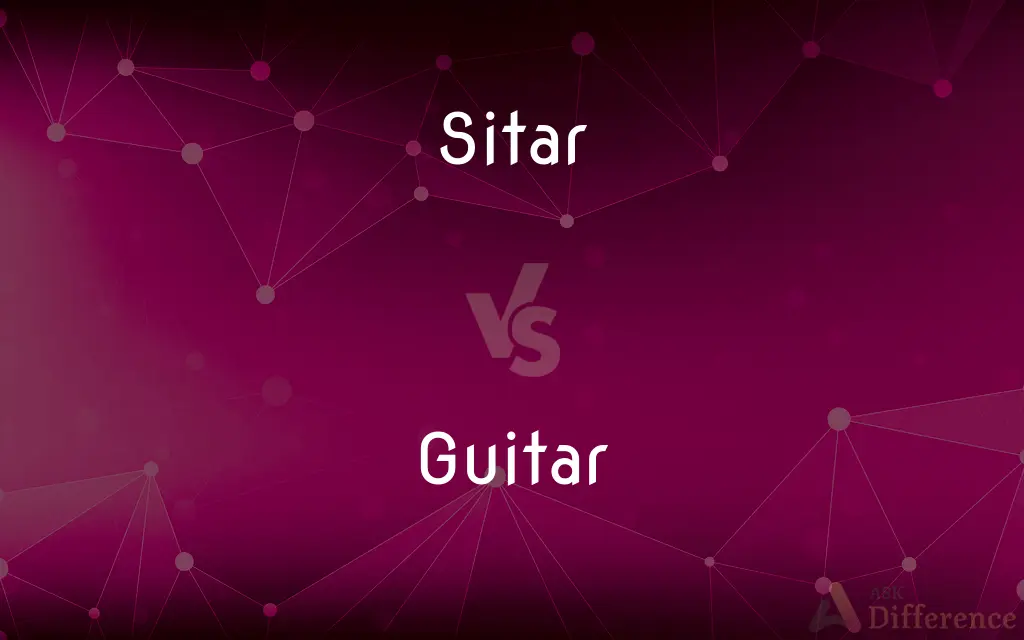Sitar vs. Guitar — What's the Difference?
By Tayyaba Rehman — Updated on October 27, 2023
The sitar is a plucked string instrument from India with a long neck, while the guitar is a globally popular stringed instrument with a shorter neck.

Difference Between Sitar and Guitar
Table of Contents
ADVERTISEMENT
Key Differences
The sitar, originating from India, is characterized by a long, hollow neck and a gourd-shaped body. The guitar, with global popularity, typically features a flat-bodied shape with a shorter neck.
Sitars usually have 18 to 21 strings, with some being drone strings. Guitars commonly have 6 strings, though variants with more strings exist.
The sitar produces a complex, resonant sound, often used in classical Indian music. The guitar offers a versatile sound, fitting into genres like rock, blues, and folk.
Playing the sitar often involves a specific finger technique using a metal or wire plectrum. Guitar playing can involve various techniques, including strumming and fingerpicking.
The sitar has sympathetic strings that vibrate to enrich its sound. The guitar, although versatile, lacks these sympathetic strings.
ADVERTISEMENT
Comparison Chart
Origin
India
Global
Number of Strings
18-21, including drone strings
Commonly 6
Sound Characteristic
Complex, resonant
Versatile
Playing Technique
Specific finger technique
Various techniques
Sympathetic Strings
Yes
No
Compare with Definitions
Sitar
Indian String Instrument
The sitar's melody resonated throughout the concert hall.
Guitar
Stringed Instrument
She played the guitar at the campfire.
Sitar
Classical Music
In classical Indian music, the sitar is a prominent instrument.
Guitar
Fingerpicking Technique
Fingerpicking on the guitar requires skill and practice.
Sitar
Sympathetic Strings
The sympathetic strings of the sitar add depth to its sound.
Guitar
Popular Worldwide
The guitar is popular in cultures around the world.
Sitar
Long-necked
The sitar's long neck allows for intricate finger movements.
Guitar
Electric and Acoustic Variants
He switched from an acoustic to an electric guitar.
Sitar
Drone Strings
The drone strings on the sitar create a mesmerizing background hum.
Guitar
Versatile Sound
The guitar's versatile sound suits many music genres.
Sitar
The sitar (English: or ; IAST: sitāra) is a plucked stringed instrument, originating from the Indian subcontinent, used in Hindustani classical music. The instrument was invented in medieval India and flourished in the 16th and 17th centuries and arrived at its present form in 18th-century India.
Guitar
The guitar is a fretted musical instrument that typically has six strings. It is held flat against the player's body and played by strumming or plucking the strings with the dominant hand, while simultaneously pressing selected strings against frets with the fingers of the opposite hand.
Sitar
A stringed instrument of India having a seasoned gourd for a body and a hollow wooden neck with movable raised frets. Stretched over the frets are usually 6 or 7 metal strings on which the melody is played with a pick, and stretched under the frets are 11 or more sympathetic resonating strings.
Guitar
A stringed musical instrument, with a fretted fingerboard, typically incurved sides, and six or twelve strings, played by plucking or strumming with the fingers or a plectrum.
Sitar
(musical instruments) A Hindustani/Indian classical stringed instrument, typically having a gourd as its resonating chamber.
Guitar
A musical instrument having a flat-backed rounded body that narrows in the middle, a long fretted neck, and usually six strings, played by strumming or plucking.
Sitar
A stringed instrument of India; has a long neck and movable frets; has 6 or 7 metal strings for playing and usually 13 resonating strings
Guitar
(musical instrument) A stringed musical instrument, of European origin, usually with a fretted fingerboard and six strings, played with the fingers or a plectrum (guitar pick).
Learning to strum the guitar rhythmically is essential.
She was carrying her guitar in a fancily-decorated case.
The band is looking for a new guitar player.
Guitar
(musical instrument) Any type of musical instrument of the lute family, characterized by a flat back, along with a neck whose upper surface is in the same plane as the soundboard, with strings along the neck and parallel to the soundboard.
Guitar
(rare) To play the guitar.
Guitar
A stringed instrument of music resembling the lute or the violin, but larger, and having six strings, three of silk covered with silver wire, and three of catgut, - played upon with the fingers.
Guitar
A stringed instrument usually having six strings; played by strumming or plucking
Common Curiosities
Where did the sitar originate?
The sitar originated in India.
What genres typically use the guitar?
Rock, blues, folk, and many others.
Can guitars be electric?
Yes, there are electric guitars.
Is the sitar used in Western music?
Occasionally, in fusion and world music.
Is the sitar easy to learn?
It's challenging, requiring specific techniques.
Are guitars used in classical music?
Yes, particularly classical guitars.
Can guitars have sympathetic strings?
No, that's unique to the sitar.
How many strings does a sitar have?
Typically 18 to 21 strings.
What's unique about a sitar's sound?
Its complex, resonant quality.
Do all guitars have 6 strings?
Commonly, but there are variants.
Can guitars be used for solo performances?
Yes, they're versatile for solo or ensemble play.
Are there different types of guitars?
Yes, including acoustic, electric, and bass.
Do sitars have frets?
Yes, they have movable frets.
What's the role of drone strings on a sitar?
They provide a continuous harmonic background.
Is the sitar common in pop music?
Rarely, it's more common in traditional Indian music.
Share Your Discovery

Previous Comparison
Order vs. Regularity
Next Comparison
Coat vs. OvercoatAuthor Spotlight
Written by
Tayyaba RehmanTayyaba Rehman is a distinguished writer, currently serving as a primary contributor to askdifference.com. As a researcher in semantics and etymology, Tayyaba's passion for the complexity of languages and their distinctions has found a perfect home on the platform. Tayyaba delves into the intricacies of language, distinguishing between commonly confused words and phrases, thereby providing clarity for readers worldwide.














































